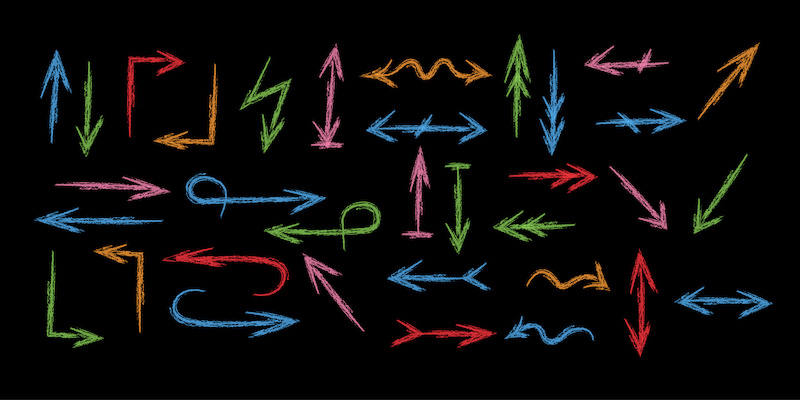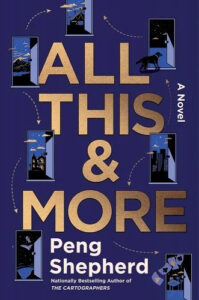THE AUTHOR
Having just survived writing a speculative mystery novel that allows readers choose what happens at certain points in the story, when CrimReads asked me to write an essay about the experience in the same format, I felt:
Terror
Excitement
*
TERROR
It’s already hard enough to write a book. But to write one in which there are multiple versions of the main character’s story, all of which make sense, and more importantly, all of which feel just as true, was a whole new beast entirely. What if I’ve bitten off more than I can chew? What if readers think it’s too weird? What if I fail? The writing of the manuscript really was like a microcosm for life.
And this is the thing, both about writing and about life: one of the best parts is getting to make choices about what’s most important, because that’s how you define yourself as “you”—and one of the hardest parts is having to make choices about what’s most important, because you might get it wrong. And if you do, how do you live with that?
Nostalgia
No Good Options
*
NOSTALGIA
Many of us are familiar with the children’s Choose Your Own Adventure series of books from our childhood, in which you start as a blank “You” canvas and are immediately launched into an outlandishly fun adventure in outer space or on the open seas or deep in some jungle.
Why did we all love that series so much as kids? What was it about those paperbacks that could transport us somewhere else for entire afternoons at a time? My personal theory is that choice is exciting to children because at that age, you almost never get to make them. Most of your life is dictated by your parents or your teachers, and so any opportunity to exercise some autonomy, no matter how trivial, is thrilling. If you put on a blue shirt for bed, will the aliens invade Earth? If you have the granola instead of the chocolate puffs, will a portal open in your basement?
But when you’re an adult, the game changes. Now you have entirely too much choice, none of which leads to extraterrestrials or SCUBA diving for lost treasure in the Bermuda Triangle. The responsibilities can be so much, we might almost wish that sometimes, the pressure of choosing could briefly be taken away from us again.
Then it was.
You can only go to “No Good Options”
*
NO GOOD OPTIONS
In January 2020, my life was upside down. I was living in a city that didn’t feel like home to me and missing New York, deeply stuck on the final draft of my previous novel, The Cartographers (which was one of the hardest revisions I’ve ever done), and dealing with some serious family issues. And then, well… we all know what happened.
Overnight, the world went from a race to a standstill. And during that enforced pause, it was hard for us not to look inward and take an inventory of our lives—myself included. Was I happy? Had I made the right choices? Should I throw it all away and try to start over? Should I just go stand outside in the grass for five minutes and then Zoom a friend with some wine instead? I kept thinking, if only there were some kind of magic reset button, surely, I’d be able to do much better a second time around.
I waited, climbed the four walls of my home, and waited more, but I couldn’t quit thinking about this dream of a magic reset button, and all the ways in which it could be used. In my brainstorming notebook, the sparkling kernel of a new idea slowly began to grow.
And that’s how I ended up writing a novel that contained multiple paths.
What if?
Traditions
*
WHAT IF?
All This and More is a roller coaster falls somewhere between a mystery and a thriller, with a healthy dose of science fiction and a dash of romance.
All of us have had to face difficult choices or grapple with regret over things we wish had gone differently. But what if you actually could go back and fix your past mistakes? How would that change your life? And would it be worth what you’d have to give up?
This is exactly what happens to Marsh, a woman full of regrets who wins a once-in-a-lifetime opportunity to become a contestant on the mysterious game show “All This and More,” which as swept the world by storm with its miraculous promise: if you’re willing to accept the consequences that tampering with your past could bring, the show will literally change your present life.
Marsh accepts without hesitation—but rewriting your past choices is never that simple. When glitches begin appearing in her perfectly crafted future, and she discovers evidence that someone or something may be trying to manipulate her fate at the same time, Marsh must decide just how far she’ll go to get her elusive happily ever after.
But it doesn’t stop there. I really wanted readers to be able to not just read a novel about a person thrust into Marsh’s miraculous situation, but also to experience firsthand what they would change about their own pasts if they could, and consider what those changes might cost them. All This and More can be read straight through like a typical novel, but at certain points in the text, the book will give you the chance to help Marsh choose what she alters about her life—and you can decide whether to keep reading her story as it’s laid out or to change her path.
Traditions
The reader
*
EXCITEMENT
Remember the joy of getting a new book from the library or bookstore, as a kid? A whole new adventure waiting for you to get lost in—probably you’d already dove into the first few pages in the car or on the bus before you even got home. Working on this book was like that for me, as the writer. Writing a novel is a very, very long game, and even on the best of days, the end of your manuscript seems very far away.
It was an incredible challenge to build a premise that could support multiple versions of the same story, to weave them together into an organized web, and then allow you to be able to jump between the strands without losing your way. It kept me returning feverishly to the keyboard day after day, excited to push myself and the book—and maybe you, too—to its limits.
Yes, an interactive fiction might ask a little more of its readers than a conventional book, but it’s worth it. They’re really able to really make you part of their story in a way that many other books can’t, and finding your way through it offers the same kind of fun as assembling a puzzle or solving a riddle. But in the case of my novel, there’s also the very meta aspect of having to make decisions for a character who’s been given the power to explore what her life would have been like if she’d made different choices. By choosing yourself, you have to declare what matters to you, both as a reader and as a person. And that’s exactly what All This and More is about.
Nostalgia
No Good Options
*
TRADITIONS
All This and More is not the first of its kind for adults. One of the earliest novels with multiple paths is the 1930 Consider the Consequences by Doris Webster and Mary Alden Hopkins, which let readers make decisions about the romantic life of a woman being courted by two suitors, and offered a staggering forty-three possible conclusions. There’s also Hopscotch by Julio Cortázar (published in 1963, translated into English in 1966), which allows the reader to freely jump between sections as they please; Neil Patrick Harris’s Choose Your Own Autobiography; Carmen Maria Machado’s absolutely chilling chapter about being trapped in an abusive relationship in her memoir In The Dream House; the fantastical, continent- and time-spanning Crossings by Alex Landragin; and many more.
Several of our most modern forms of storytelling have embraced this branching path aspect as well. On television, Netflix’s recent Bandersnatch allowed viewers to push the troubled young man at the heart of a dark, surreal mystery to his limits, and video games have been asking players to make decisions for their characters and shape their destinies for years.
No matter your age, there’s a whole world out there full of deep, complicated stories which ask you to go beyond passive reading—to more actively participate in the tale you’re enjoying.
What if?
The Reader
*
THE READER
Congratulations! You’ve made it to the end. Having just finished reading an essay that allowed you to progress through it in multiple ways, hopefully you feel entertained, intrigued, or even hungry for more—but I will leave that up to you to decide.
Through their stories, all books are trying to ask you a question. But a book that requires you to make choices to reach the end does not simply pose its question, but really implores you to answer it.
Now, the only question left is, what will you read next?
All This and More
***


















